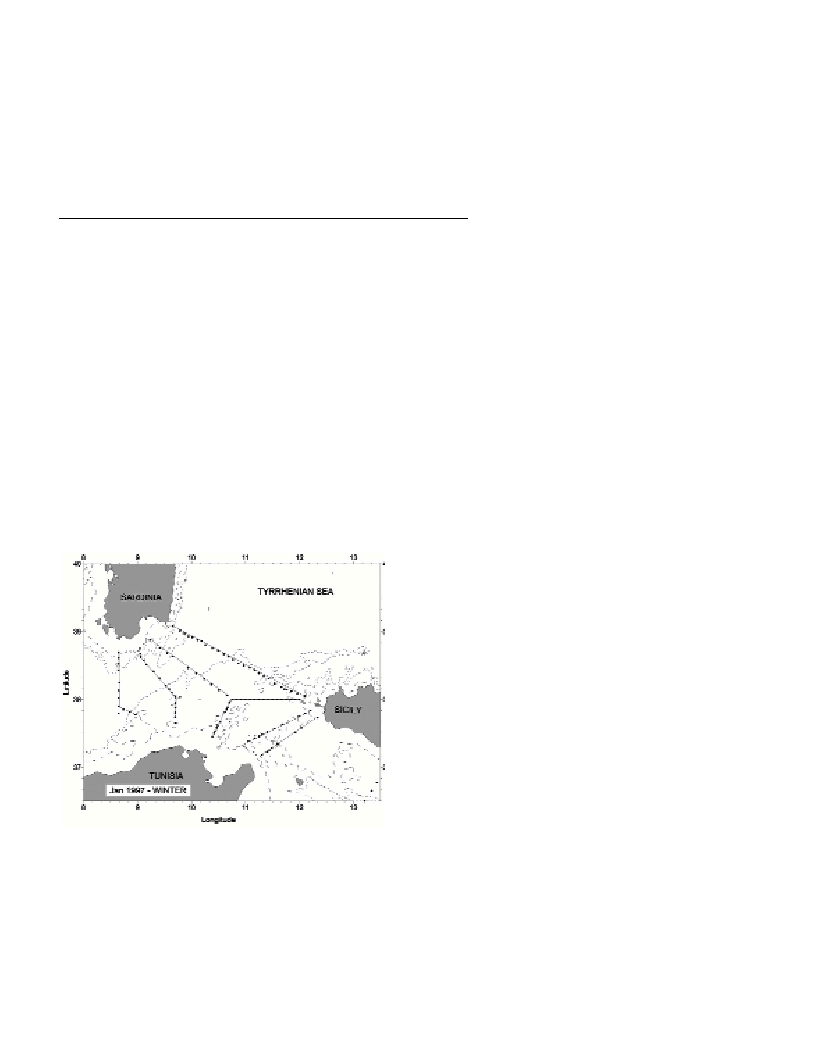Rapp. Comm. int. Mer Médit., 37,2004
149
SURFACE CIRCULATION AND FLUXES INSIDE THE CENTRAL MEDITERRANEAN SEA
Vetrano A., G.P. Gasparini* and M. Astraldi
Consiglio Nazionale delle Ricerche, Istituto di Scienze MARine, Sezione territoriale di La Spezia, S. Terenzo loc. Pozzuolo,
La Spezia, Italy - anna.vetrano@sp.ismar.cnr.it
Abstract
A composite data set of hydrographic measurements, SST and current data was used to describe the Atlantic Water circulation in the
Central Mediterranean Region during different seasonal periods. While the mean current features were estimated applying to the region
an inverse box model, the shorter variability was investigated using the remote sensing SST and currentmeter measurements. A special
attention was devoted to understand the role played by the wind field in determining the main features and their variability.
Keywords: Sicily Strait, Sardinia Channel, Inverse box model, surface circulation
Introduction
The Central Mediterranean connects the Ionian basin with two
main basins of the Western Mediterranean: the Tyrrhenian and the
Algerian Seas. The principal water masses forming the circulation of
the Mediterranean Sea are forced to ?ow through the region, which
then become essential for the assessment of water budget of the whole
basin. For these reasons, the area has been extensively investigated
since the ‘70s (1; 2; 3). Recently (4) have qualitatively described the
general circulation of the area while (5) have provided a quantitative
estimates of seasonal water ?uxes. This present work is devoted to
improve the resolution of the surface mesoscale structures and to
explore the main forcing of the region.
Seasonal hydrographic surveys were conducted in the Central
Mediterranean between November 1993 to June 2000 (Fig. 1). The
data-set includes CTD measurements along several sections, long-
term current measurements and several VM-ADCP data. The data-set
has been integrated with the ECMWF data at 10 m, used to define the
wind stress curl field with a spatial resolution of a half degree.
Moreover, several remote sensing SST images have been retrieved
during a period including the CTD cruise spanning-time. This was
done in order to follow the time evolution of the mesoscale structures
pointed out through hydrographic measurements (usually extending
over a period of about 20 days).
Fig. 1. Measurement sites in the Central Mediterranean Sea during
January 1997.
Results
The result of the model is a mean circulation over the region. The
reference velocity, obtained as the system solution by SVD inversion
method (6), is applied to the initial geostrophic velocity field, to
obtain the absolute geostrophic ?ow. The surface ?ux patterns shows
a main vein of Atlantic Water ?owing from the Algerian Basin ranging
from 2.24 to 0.97 Sv. The major part enters into the eastern
Mediterranean basin. This vein is subject to important mesoscale
phenomenon inside the Sicily strait region, where the recirculation
may have the same relevance of the mean ?ow. Similar recirculation
also occurs inside the Sardinian Channel, and it was estimated to be
about half of that occurring at the sill strait region. The vein entering
the Tyrrhenian Sea varies from 0.1 to 1.2 Sv. It recirculates
cyclonically into the basin and exits along the Sardinia cost. This
out?ow varies between 0.38 and 0.82 Sv.
The main structures estimated by the model are in good relationto
the remote sensing SST and current-meter data relative to the
measurements period. Two relevant features can be observed: a cold
and salt cyclonic circulation subsists to the northwestern side of the
region, whereas a warmer and fresher anticyclonic structure prevails
to the south. The wind stress curl was calculated from ECMWF and
related to the circulation and SST fields. The analysis confirms that
both structures are wind-driven and may have a significant role in
modulating the mean ?ow through the region.
References
1-Garzoli S. and C. Maillard, 1979, Winter circulation in the Sicily and
Sardinia Strait region. Deep-Sea Res.,26A: 933-954.
2-Grancini G. F. and A. Michelato, 1987, Current structure and
variability in the Strait of Sicily and adjacent area. Ann. Geophys.,5B, 75-
88.
3-Astraldi M., G.P. Gasparini, S. Sparnocchia, M. Moretti and E.
Sansone, 1996, The Characteristics of the water masses and the water
transport in the Sicily Strait at long time scales. In: Dynamics of
Mediterranean straits and channels, CIESM Science Series n.2, Bull. Inst.
Oceanograph., Monaco,n. special 17: 95-115.
4-Astraldi M., G.P. Gasparini, A. Vetrano and S. Vignudelli, 2002,
Hydrographic characteristics and interannual variability of water masses
in the central Mediterranean: a sensitivity test for long-term changes in the
Mediterranean Sea. Deep-Sea Res.,49: 661- 680.
5-Vetrano A. G.P. Gasparini, R. Molcard and M. Astraldi, 2003, Water
Flux Estimate in the Central Mediterranea Sea from an Inverse Box
Model, J. Geophys. Res., in press.
6-Wunsch C. , 1996. The ocean circulation inverse problem, Cambridge
University Press, 442 p.

